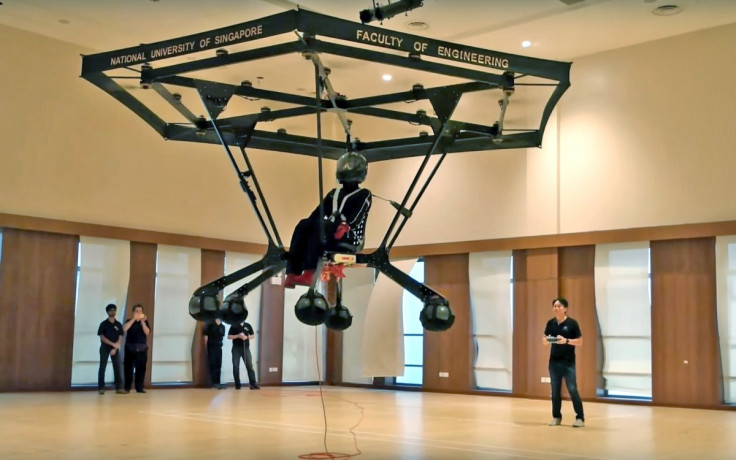Singapore university students develop their own Star Wars personal flight vehicle

Students from the National University of Singapore (NUS) have made their own foray into the race to build the first viable personal flight vehicle by creating a huge multicopter drone that can carry a person and hover in the air.
The concept of a personal flight vehicle is one that has always been on the more adventurous spectrum of inventions, and the best way to describe one is to say that it is similar to the podracers that appeared in Star Wars Episode I: The Phantom Menace.
The NUS invention, named Snowstorm, was built by eight students from the Engineering Faculty at NUS and took a year to complete. It features a hexagonal frame made from aluminium beams, carbon fibre plates and tubes with Kevlar ropes, with 24 motors driving 24 propellers that each measure 76cm in diameter overhead. Each motor generates 2.2kW of power and the whole device requires three rechargeable lithium batteries generating a total of 52.8kW to power it.
Similar to other personal flight vehicles being developed around the world today, Snowstorm is designed to take-off and land vertically. Its pilot seat is supported by six landing gear legs and beneath the seat and inflated ball is positioned to absorb shock from landing, while the seat is installed with a five-point harness.
A giant drone you can fly in
Snowstorm is able to carry a payload of 70kg (154lbs) and can stay in the air for five minutes but the university has not said how much the entire device weighs. The vehicle was tested successfully indoors in a university gymnasium and the test flight showed Snowstorm could hover in the air safely and move across the room before landing.
NUS says Snowstorm includes sophisticated unmanned aerial vehicle (UAV) software that is able to automate flight to maintain position in the air and the vehicle's position at a set altitude, but in the test flight video, the vehicle was powered by a man with a controller on the ground.
"Designing and building Snowstorm was a great learning opportunity for us. The toughest part of this engineering challenge was ensuring a good thrust to weight ratio to allow the craft to lift a person into the air," said Shawn Sim, a third-year NUS engineering student.
"At every stage of our design, we constantly had to balance and consider trade-offs between the types of materials, their characteristics and weight. In some instances, we even 3D-printed parts, such as our landing gear mount, just so we can have a customised and optimal fit."
Three other parties racing to build personal flight vehicles
The vehicle developed by NUS is impressive but there are other personal flight vehicles that have made great achievements, including outdoor manned flights.
First, there's Flike, a personal flight vehicle designed by the Hungarian government's research institute Bay Zoltan Nonprofit. Flike is a tricopter that can carry a total weight – including payload – of 240kg. In April, Flike completed a successful manned test flight where it was able to hover and manoeuvre in the air while compensating for the wind, for one and a half minutes.
Then there's the Hoverbike by UK firm Malloy Aeronautics, which raised £64,000 ($100,000) on Kickstarter in August 2014 and has had several successful test flights, but the firm is still working through technical difficulties, so for now, Malloy Aeronautics has released a one-third-scale drone in order to raise funds and repay people who backed the Kickstarter.
Finally, a Dutch UAV engineer named Thorstin Crijns held a successful test flight for his personal flight vehicle, Quadro UAS, which has a lightweight aluminium frame and requires 20 engines and rotors generating 282 pounds of thrust to carry 243lb of weight (including a 132lbs payload), powered by 10 lithium-ion polymer batteries.
None of these solutions are ready to be commercialised yet – Flike has been spun off to become a tech startup and is seeking investors; Mallow Aeronautics is working with the US Department of Defence to realise the Hoverbike within the next three to five years; and Crijns is continuing development of the Quadro UAS with the goal of making the vehicle fully autonomous.
© Copyright IBTimes 2025. All rights reserved.






















